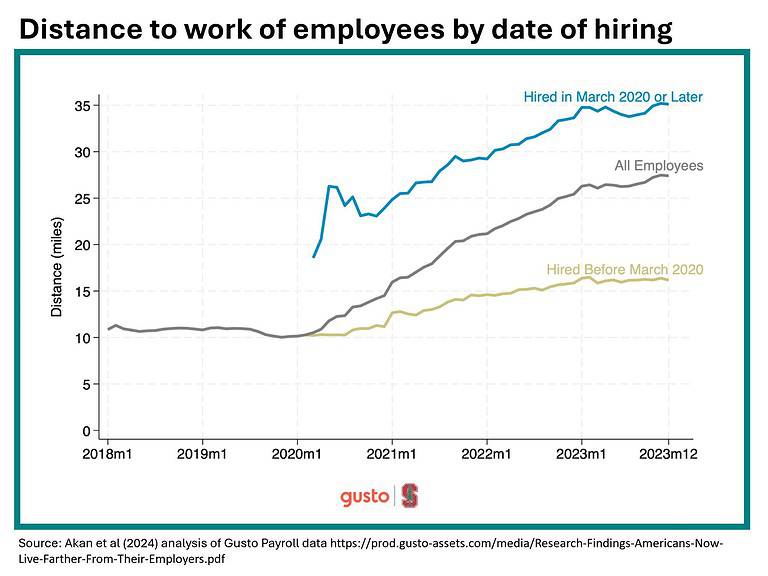At the height of the COVID-19 pandemic, companies allowed workers to complete tasks at home, encouraging them to stay away from the office and remain healthy.
Although life continues on, saying we are back to normal would be a stretch. The pandemic altered the world in ways people couldn’t have imagined, including the way we work. Add to the mix the rapid advances in artificial intelligence (AI) and the way we do our jobs, and you can see why there is a raging debate about when and how people should work.
In January 2024, Boeing and UPS called workers back to the office for a five-day workweek. IBM said if managers weren’t going to be in the office three days or more a week, they should leave the company. Goldman Sachs said employees need to be in the office daily, and Google began factoring in-office attendance into their performance reviews.
One survey by Resume Builder showed 90% of companies plan on a full return to the office by the end of 2024. The reality may be quite different than CEOs expect, though. Workers are pushing back, and some outright quit rather than commute every day.
Are companies entitled to force workers to return to the office? Here are the pros and cons of the return and some ways to manage the transition back to the office.
Why Are Employees Resisting Returning to the Office?

Remote work has enabled employers to find talent way hundreds or thousands of miles away from their HQ.
Reasons why workers want to remain remote are varied. Some like the time-saving factor of not having to commute to the office. Those who have children in school may need the extra hour to get their child on the bus before sitting down to work for the day. On the opposite end of the work day, they enjoy wrapping up and going right to preparing dinner with the family.
Some may be or live with an immunocompromised person and want to avoid bringing home germs that might harm their loved one or themselves. Remote work options have brought peace of mind to anyone who might be at risk of illness.
The costs of working in an office are also greater for the worker than staying at home. You save money on fuel, car repairs, parking, lunches out and work clothes in most cases.
Checkout this insightful episode on remote working with Nick Bloom on the Great Leadership show
Why Companies Think They Should End Remote Options
Companies claim they are seeing a higher return on profits since implementing return to office (RTO) policies. They feel workers are more productive and believe having their staff in-office improves communication and a sense of company culture.
Although many brands want their staff back in the office, they also see the benefits of a hybrid approach. Not only can they utilize less office space and cut expenses when they have rolling days in-office, but workers are happier and enjoy the perk and flexibility.
When it comes to collaborating with other workers and clients, it is a bit easier to coordinate face-to-face meetings.
Some managers may worry people aren’t putting their all into their work without the oversight they get from being in the same building. Unfortunately, a few poor workers may ruin the opportunity for remote work for others. While it isn’t fair, it is a valid concern companies have that some people take advantage and don’t work as hard as they would in an office setting.
What to Do If Your Company Asks You to Return
If you’re a remote employee and worried your company might ask you to return to the office full-time this year, you have numerous options. Remain respectful and address your concerns. Even if they ask the majority of the staff to RTF, you may be able to negotiate a hybrid or occasional drop-in approach for your position.
1. Assess Remote Benefits for Your Role
Make a list of the tasks you can only complete in the office and figure out what percentage of your work could conceivably be completed at home. You’ll have an easier time convincing management to allow you to continue working at home part of the time if you can show the low impact of allowing you to do so.
Be fair. If your company has a weekly meeting and it works better when everyone is present, mention that you understand the need to be in the office for the meeting.
If your role isn’t currently remote but you’d like it to be, ask for a few days at first so you and the employer can assess the changes.
2. Explain Anxiety or Health Issues

If you have health issues — including anxiety and mental health struggles — you may have an easier time convincing your employer to let you work remotely.
If you feel anxious at work or have a medical condition, talk to a doctor or mental health professional about writing a note to your employer. Most managers are sympathetic to health concerns and will work alongside you to find a solution that helps them retain valuable and skilled staff members.
3. Negotiate a Raise to Cover Added Costs

If you’re concerned about the additional costs of commuting to and from work or clothing, ask your manager for a raise. In situations where remote work was promised long-term and is now being taken away, you may be able to negotiate a higher wage to make up for it.
Never threaten to leave for a different position during negotiations. You may not have something lined up yet and most states are at-will employment situations, which means you or your company can part ways without any reason other than the desire to.
Here are some great tips on how to convince your company to let you go remote
4. Highlight Better Productivity
U.S. News reports that there are three times the amount of remote positions now than there were in 2019 prior to the pandemic, and at least half or people want to work from home at least some of the time.
Point out the areas where you’re able to be more productive at home. Perhaps your cubicle is close to the copy machine and you get distracted every time someone comes to use it. Maybe you can take a five a.m. overseas call when you work from home but wouldn’t be able to if you were in the middle of a commute.
Make a list of the reasons why you’re more productive at certain tasks at home and how the office environment is detrimental to that work. You may be able to win at least a couple of days at home based on your presentation.
5. Point Out Green Benefits

Working from home reduces your carbon footprint. In a study on emissions, researchers found full-time remote workers produced less than half of what office workers did. Many companies make a commitment to the environment. Point out how they can be greener by allowing remote or remote-hybrid work.
6. Remain Positive

If your company still insists you return to the office, try to keep a positive attitude. Some brands are tying days in the office to performance, such as Google. Others have made it clear they will fire anyone refusing to come back.
Focus on the advantages of being in the building, such as getting advice from more experienced co-workers, better collaboration and making key connections that might spur your career growth.
7. Consider Alternatives
Currently, the job market is still open. If the company you’ve invested in refuses to allow remote work and you want to work from home, start the search for a different position. You may be better able to negotiate hybrid options with a new company.
One of the reasons for the employee shortage is that people left to start their own businesses during the pandemic and got a taste of working for themselves. The gig economy and small business industry is still thriving in 2024. You can even start a side hustle and see how it goes before leaving your employer.
8. Do a Cost Analysis

Most CEOs want to make the most profit for the least investment. If you can list the ways that working from home saves the company money, you may have a case for at least working remotely most of the time.
Write out the costs of having you there, from energy to equipment to coffee to loss of productivity during commutes. If you make the company more money as a result of working from home, such as putting in unusual hours they’d normally have to hire and pay someone time and a half to complete, list that out as well.
Managers tend to like to see facts and figures in black and white. If you can prove the worth of remote work, they may choose to let you continue or begin it.
How Long Will the Standoff Last?
It’s hard to say how long CEOs will continue the demand for people to return to the office. They’re paying for the building and like to see warm bodies filling the space. However, many workers are leaving or quietly quitting.
While companies want to tie attendance to performance and bring people back together, the job market hasn’t tightened the way they thought it would in 2023. Many roles remain unfilled, and the fear of losing top talent remains.
Whether those concerns translate to backing off the return to office culture remains to be seen. For now, remote workers should continue doing their top work, point out the benefits to the company and work with their managers to come up with a solution everyone can live with.









